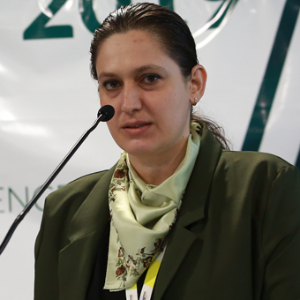Title : Comparative investigation on two different populations of Lamium garganicum subsp. striatum var. microphyllum (Lamiaceae) distributed in Turkey
Abstract:
- How much do the two populations differ from Mill (1982)’s and Mennema (1989)’s descriptions and each other, morphologically?
According to Flora of Turkey, Mill (1982) recorded that L. microphyllum and L. sandrasicum are endemic alpine species, respectively distributed on Honazda? and Sandras da?? in Denizli. Mennema (1989) has regarded L. microphyllum and L. sandrasicum as synonyms of L. garganicum subsp. striatum var. microphyllum in the recent monograph of the genus Lamium. In the present study, the two populations are corresponded to the synonyms L. microphyllum and L. sandrasicum, respectively. We will present the detailed morphological descriptions by photographs, illustrations, tables and measurements in this section. The morphological data will be compared to Mill (1982)’s and Mennema (1989)’s descriptions to update information. According to our morphological data the two populations appear different enough from each other to be able to be evaluated in higher taxonomic categories.
- How much do the populations differ from each other anatomically?
We will present detailed anatomical descriptions of the investigated populations by photographs, tables and measurements in this section. According to Metcalfe & Chalk (1972) a quadrangular stem and a well-developed collenchyma, supporting tissue at the corners of stem is the characteristic feature of Lamiaceae family. The two populations reflect general character of the family, having collenchymatous tissue at the corners of the stems, which, in particular, is clearly detectable in the hand blade sections.
However, certain anatomical differences were detected between the two populations besides so many similarities. Glandular hairs were classified according to Werker et al (1985) and Werker (1993) in this study. Glandular hair diversity is one of the most important differences between the two populations.
- How much do the populations differ anatomically from the other investigated Lamium taxa in the family?
We will compare the investigated populations with the other investigated Lamium taxa, anatomically in this section. Lack of extraxilar sclerenchyma in the roots or stems is one of the most important common points for both the investigated populations and other Lamium taxa (Baran & Özdemir 2009, 2011, 2013, Özdemir & Baran 2012, Celep et al 2011, Atasagun et al 2015, Atalay et al 2016).
The presence of glandular hairs on the leaves, especially at the margins of calyx teeth is one of the conflicting points with Mennema (1989). On the otherhand, there have also been few conflicting anatomical points for the same taxa reported by Atalay et al (2016), the recently done comprehensive work on Turkish Lamiums. The possible reasons of the conflicting points are discussed.
- What points should be taken into consideration unbiasedly in an integrative review of the genus Lamium?
This population study points out that there are some issues that need to be considered in order for anatomical studies to contribute to systematic knowledge, correctly.
- Long-term and intensive chemical treatment methods, such as the paraffin method, can lead to the erosion and loss of certain soft tissue types of systematic importance, leading to incomplete or inaccurate information about the plant taxa.
- Especially few layered collenchymatic tissues may have lost in alike methods.
- Hand-blade section, a conventional method, should not be neglected for Anatomical Studies.
- Particularly, it should be used to determine the types of collenchymatic tissue such as angular, plaque and lacunar.
- When examining glandular trichomes;
- Hand-blade sections should be used in light microscopy.
- The appropriate sample should be prepared from fresh material instead of dry material in scanning electron microscopy
- Secretion mode described by Werker et al (1985), Werker (1993) should be included in classification. This can make a greater contribution to illuminating systematic problems in the genus Lamium.
In order to reveal the general anatomical features of a plant taxon and use it in taxonomy, it is necessary to examine different populations of the same taxa and also as many samples as possible in a population.



